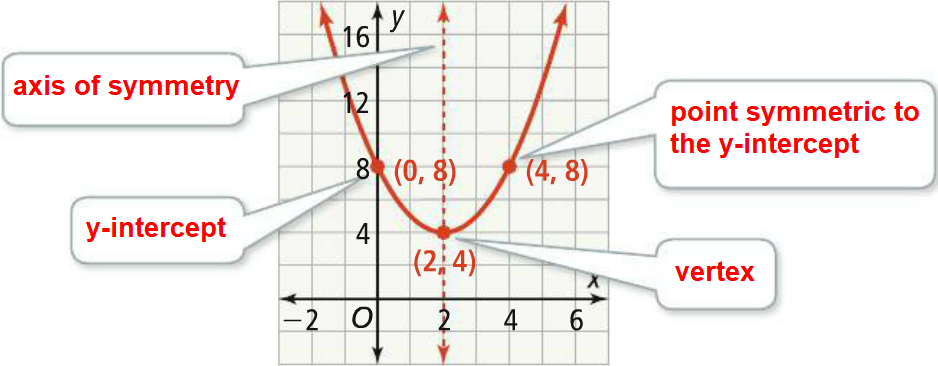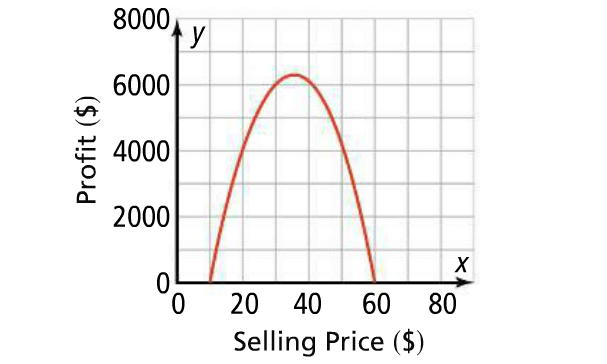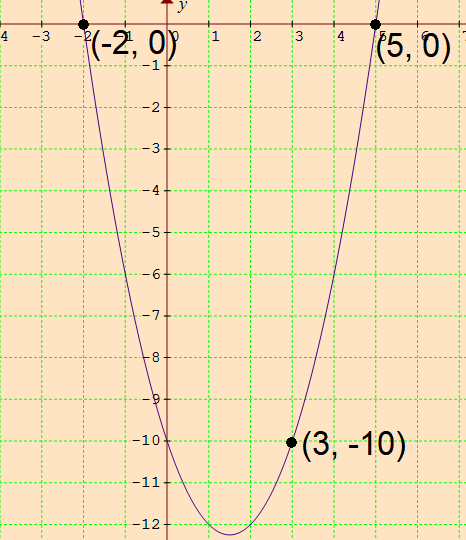STANDARD FORM OF A QUADRATIC FUNCTION
Subscribe to our ▶️ YouTube channel 🔴 for the latest videos, updates, and tips.
The standard form of a quadratic function is
y = ax2 + bx + c
where a, b and c are real numbers, and a ≠ 0.
Using Vertex Form to Derive Standard Form
Write the vertex form of a quadratic function.
y = a(x - h)2 + k
Square the binomial.
y = a(x2 - 2xh + h2) + k
y = ax2 - 2ahx + ah2 + k
The equation y = ax2 - 2axh + ah2 + k is a quadratic function in standard form with
a = a
b = - 2ah
c = ah2 + k
The vertex of a quadratic function is (h, k), so to determine the x-coordinate of the vertex, solve b = -2ah for h.
b = -2ah
Divide each side by -2a.
- b / 2a = h
Because h is the x-coordinate of the vertex, we can use this value to find the y-value, k, of the vertex.
Example :
Find the vertex of the quadratic function :
f(x) = x2 - 8x + 12
Solution :
Step 1 :
Identify the coefficients a, b and c.
Comparing
ax2 + bx + c and x2 - 8x + 12,
we get
a = 1, b = -8 and c = 12
Step 2 :
Solve for h, the x-coordinate of the vertex.
h = - b / 2a
Substitute.
h = - (-8) / 2(1)
h = 8 / 2
h = 4
Step 3 :
Substitute the value of h into the equation for x to find k, the y-coordinate of the vertex.
f(4) = 42 - 8(4) + 12
f(4) = 16 - 32 + 12
f(4) = - 4
So, the vertex of the given quadratic function is
(h, k) = (4, -4)
Graphing a Quadratic Function in Standard Form
Example :
Graph the quadratic function :
f(x) = x2 - 4x + 8
Solution :
Step 1 :
Identify the coefficients a, b and c.
Comparing
ax2 + bx + c and x2 - 4x + 8,
we get
a = 1, b = -4 and c = 8
Step 2 :
Find the vertex of the quadratic function.
The x-coordinate of the vertex can be determined by
h = - b / 2a
Substitute.
h = - (-4) / 2(1)
h = 4 / 2
h = 2
Substitute the value of h for x into the equation to find the y-coordinate of the vertex, k :
f(2) = 22 - 4(2) + 8
f(2) = 4 - 8 + 8
f(2) = 4
So, the vertex is
(h, k) = (2, 4)
Step 3 :
Find the axis of symmetry of the quadratic function.
Axis of symmetry of a quadratic function can be determined by the x-coordinate of the vertex.
In the vertex (2, 4), the x-coordinate is 2.
So, the axis of symmetry is
x = 2
Step 4 :
Find the y-intercept of the quadratic function.
To find the y-intercept, put x = 0.
f(0) = 02 - 4(0) + 8
f(0) = 8
Step 5 :
Find a point symmetric to the y-intercept across the axis of symmetry.
Because (0, 8) is point on the parabola 2 units to the left of the axis of symmetry, x = 2, (4, 8) will be a point on the parabola 2 units to the right of the axis of symmetry.
Step 6 :
Sketch the graph.
Once we have three points associated with the quadratic function, we can sketch the parabola based on our knowledge of its general shape.

Interpreting the Graph of a Quadratic Function
Example :
The graph of a quadratic function
f(x) = - 10x2 + 700x - 6000
shows the profit, a company earns for selling items at different prices. Find the maximum profit that the company can expect to earn.

Solution :
The x-axis shows the selling price and the y-axis shows the profit.
The maximum y-value of the profit function occurs at the vertex of its parabola. Find the vertex of the parabola.
Use the function to find the x-coordinate and y-coordinate of the vertex.
Find the x-coordinate of the vertex.
h = - b / 2a
Substitute.
h = - 700 / 2(-10)
h = - 700 / (-20)
h = 35
Find the y-coordinate of the vertex.
y = - 10x2 + 700x - 6000
Substitute x = 35.
y = - 10(35)2 + 700(35) - 6000
Simplify.
y = - 12250 + 24500 - 6000
y = 6250
So, the vertex is
(h, k) = (35, 6250)
So, the selling price of $35 per item gives the maximum profit of $6,250.
Writing the Equation of a Parabola Given Three Points
Example :
Find the equation of a parabola that passes through the points :
(-2, 0), (3, -10) and (5, 0)
Solution :
Step 1 :
Write the three equations by substituting the given x and y-values into the standard form of a parabola equation,
y = ax2 + bx + c
Substitute (-2, 0).
0 = a(-2)2 + b(-2) + c
0 = 4a - 2b + c
Substitute (3, -10).
-10 = a(3)2 + b(3) + c
-10 = 9a + 3b + c
Substitute (5, 0).
0 = a(5)2 + b(5) + c
0 = 25a + 5b + c
Step 2 :
Solve the system :
0 = 4a - 2b + c
-10 = 9a + 3b + c
0 = 25a + 5b + c
Solving the above system using elimination method, we will get
a = 1, b = - 3 and c = - 10
Step 3 :
Substitute 1 for a, -3 for b, and -10 for c in the standard form of quadratic equation.
Hence, the equation of a parabola is
y = x2 - 3x - 10
Step 4 :
Confirm that the graph of the equation passes through the given three points.

Subscribe to our ▶️ YouTube channel 🔴 for the latest videos, updates, and tips.
Kindly mail your feedback to v4formath@gmail.com
We always appreciate your feedback.
About Us | Contact Us | Privacy Policy
©All rights reserved. onlinemath4all.com

Recent Articles
-
10 Hard SAT Math Questions (Part - 44)
Jan 12, 26 06:35 AM
10 Hard SAT Math Questions (Part - 44) -
US Common Core K-12 Curricum Algebra Solving Simple Equations
Jan 07, 26 01:53 PM
US Common Core K-12 Curricum Algebra Solving Simple Equations -
10 Hard SAT Math Questions (Part - 4)
Jan 05, 26 06:56 PM
10 Hard SAT Math Questions (Part - 4)
